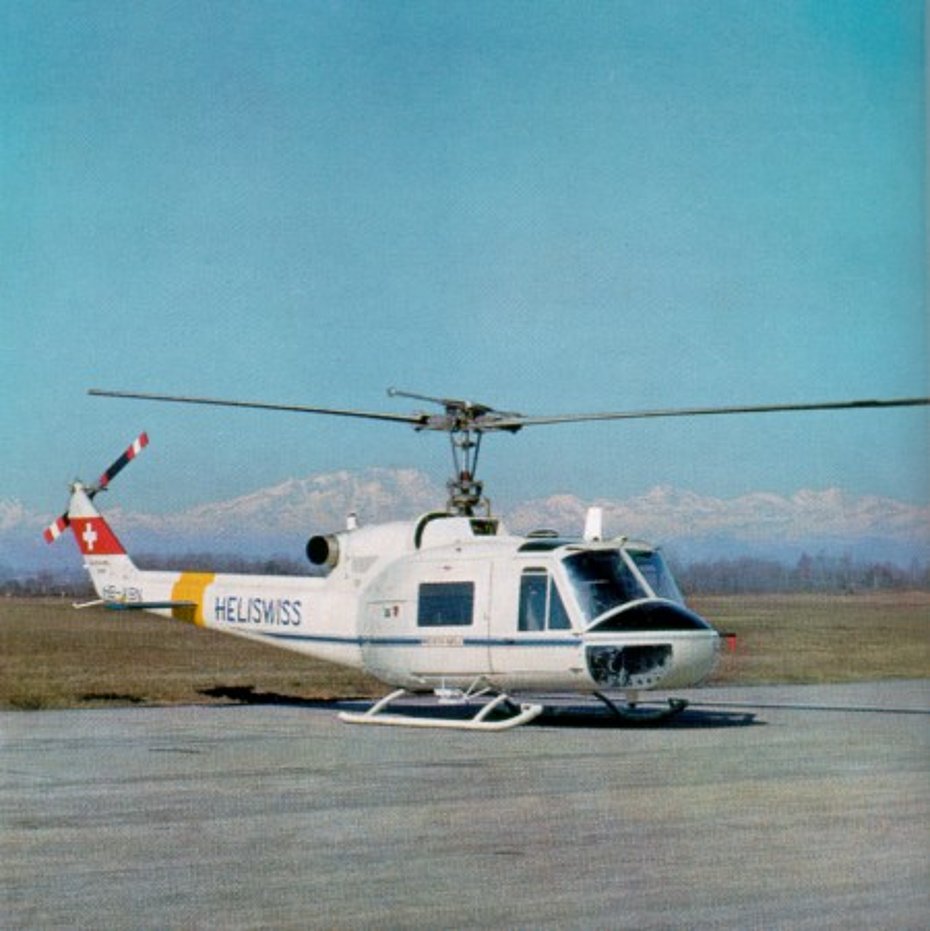
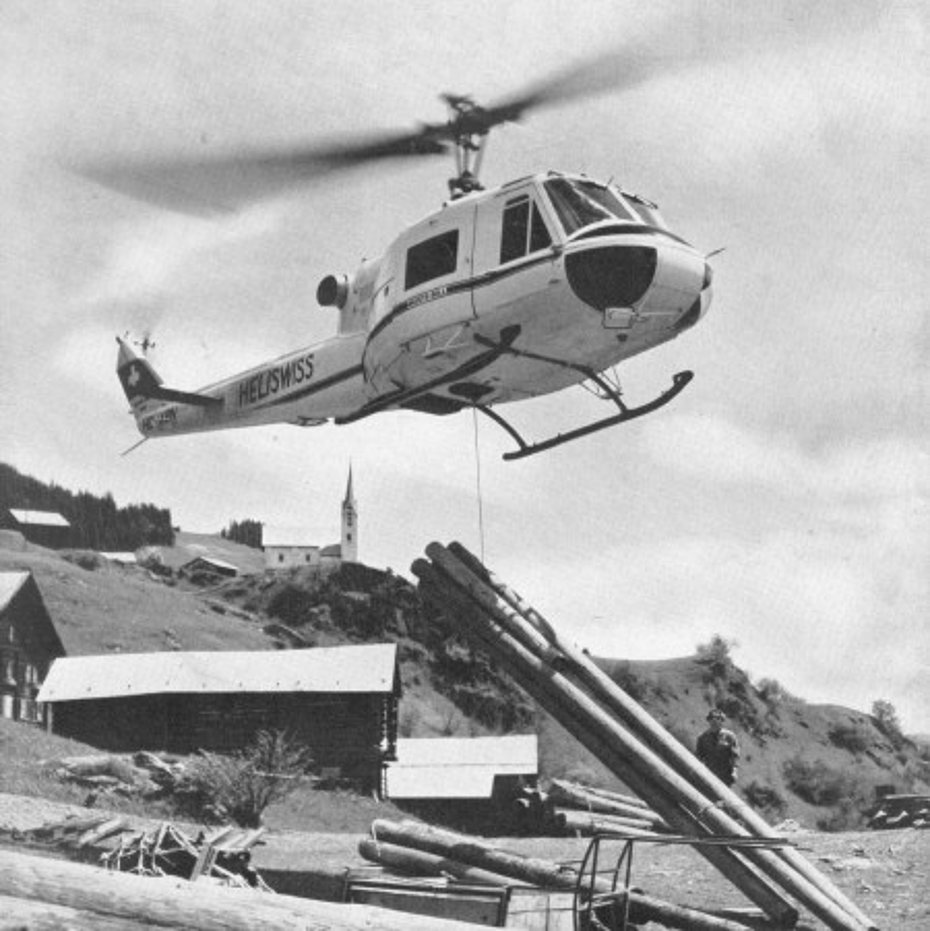
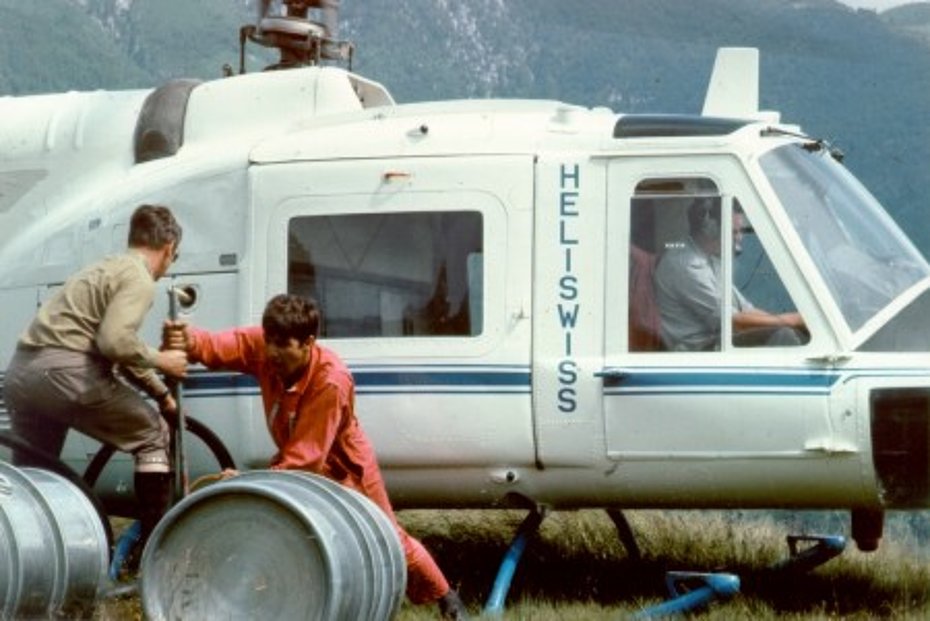
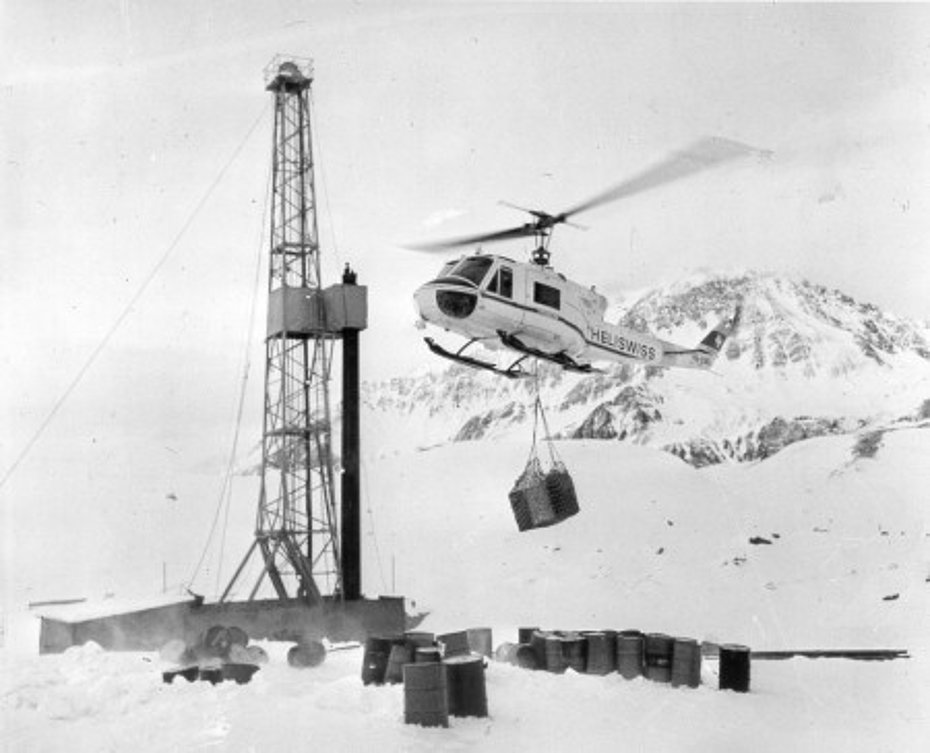
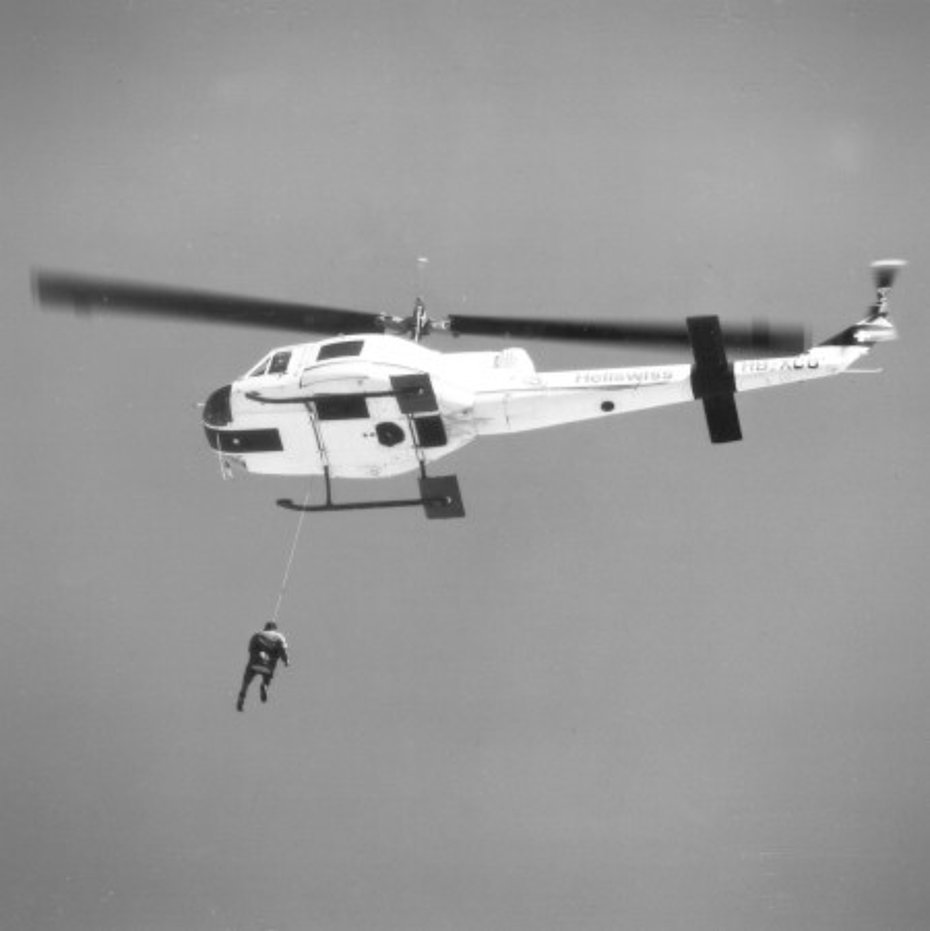
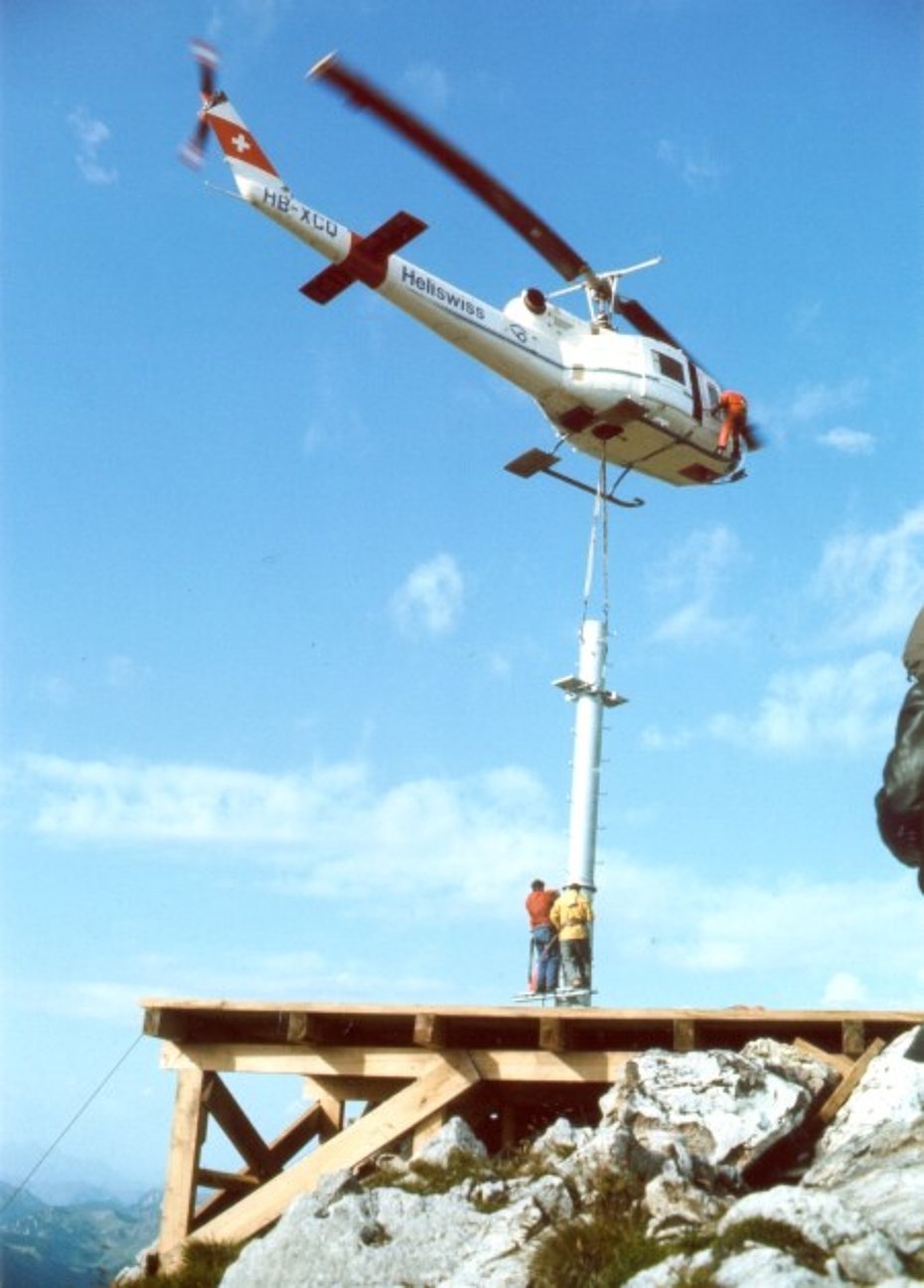
Agusta-Bell 204B - History and technical description
Some historical notes
After the commercial success obtained with the AB-47 series, the Italian company Costruzioni Aeronautiche Giovanni Agusta acquired from Bell the license to produce the Model 204. The American helicopter, which was initially designated XH-40, did its first test flight on the 22nd of October 1956. In June 1959 it became the first turbine powered helicopter to enter service with the US Army.
In 1962, when the US Army introduced its own designations, this aircraft (which in the meantime had been slightly modified) become the UH-1A (Utility Helicopter) Iroquois in honour of indigenous people of North America. Soldiers however quickly gave the helicopter the nickname Huey, which is still in common use today.
This legendary helicopter is one of the icons of the Vietnam war. The Huey was in fact widely used in this conflict for almost each kind of aerial mission.
Bell developed a long series of military versions, but obviously didn’t forget the civil market. For the latter the company developed the Model 204B certified by the Federal Aviation Administration on the 4th of April 1963.
In February 1960 Domenico Agusta, president and general director of the Agusta factory, went to Fort Worth along with the engineer Michele Demma and the test-pilot Ottorino Lancia. The main goal of that trip, which lasted several days, was to discuss with Bell the terms for the production in series of the Bell Model 204 in Italy. The two companies came to an agreement and Agusta obtained the rights to produce in series the new helicopter designated Agusta-Bell 204B.
During 1960 Agusta’s factory, which had already manufactured over 600 helicopters, worked hard to prepare the machinery necessary and the assembly line. These efforts were repaid the following year. In fact on the 11th of May 1961 the I-AGUG made its first flight in Cascina Costa piloted by Ottorino Lancia. A few days later the new helicopter was officially presented at the 24th Salon International de l’Aéronautique which took place in Le Bourget from the 26th of May until the 4th of June.
The following 10th of July it was presented to the Italian military authorities in Rome (Urbe airport). During the demonstration Lancia lifted an off-road vehicle weighting 1’400 kg.
In February of 1962 the Agusta-Bell 204B obtained the military approval. One of the first important customers was the Royal Swedish Air Force which received the first (of the 18 ordered) Agusta-Bell 204B on the 20th of February 1962. The following month Agusta delivered to its first civil customer, the Norwegian Helikopter Service based in Oslo, the Agusta-Bell 204B registered LN-ORM.
In Italy the first civil customer was probably AGIP Mineraria which received the I-MINB that same year. This company was followed by Elivie which put the I-ESET in service on the 30th of June 1963.
The Agusta-Bell 204B had a good commercial success. From 1961 to 1973 Agusta produced altogether 243 units. Most of them were delivered to military customers. Among these there were the Austrian Air Force (26), the four branches of the Italian Armed Forces (97), the Royal Swedish Air Force (18), the Royal Netherland Navy (9) and the Turkish Army (18).
The commercial success of the Agusta-Bell 204B was probably prematurely interrupted by the appearance of the more powerful and spacious 205. This model, manufactured in series by 1965, had in fact a greater success and was produced in 546 units.
Technical description
At first it is necessary to clarify that Agusta certified five versions of the Agusta-Bell 204B (RAI approval certificates number A-129, A-135, A-137 - applicable on two versions, and A-150). The main differences concern the turbine, the rotor (44 or 48 foot) and the payload.
The technical information mentioned in this article usually refers to the first Agusta-Bell 204B employed by Heliswiss which was registered HB-XBN.
The Agusta-Bell 204B is a so-called helicopter of the second generation of standard configuration. The main rotor is the classic Bell with stabilizer bar and all metal interchangeable blades.
The all-metal tail rotor blades have an internal honeycomb structure which adds strength and safety. The fuselage consists of two main sections. The front section includes the crew and passenger locations, while the rear section supports the tail rotor and the synchronized elevator. The forward section is of all metal construction except for some fibreglass coverings. The tail boom is of semi-monocoque structure employing magnesium and aluminium alloy elements.
The pilot’s and co-pilot’s seats are located respectively on the right and left side of the front cabin. In the passenger transport configuration, provisions are made to accommodate up to nine (ten in some versions) passengers. With seats removed the space available in the cabin is about 4 cubic meters. There is one door on each side located frontally, one for the pilot and the other for the co-pilot. To the entrance the passengers compartment there are two sliding doors. If necessary these can be easily removed. Large Plexiglas windows provide full-view for passengers and wide-angle scanning for the crew. The windows under the nose hood allow for easy hooking and release of external loads. On the left side of the tail boom there is a baggage compartment where it is possible, in compliance with the weight and balance diagram, to load up to 250 kg.
Hinged cowling sections surround the 204B’s turbine and transmission. These can be swung open to expose the complete components as well as a work platform which supports a maintenance hoist and simplifies in-the-field maintenance.
The HB-XBN was powered by a De Havilland (the turbine's name then changed into Bristol Siddeley and successively Rolls-Royce) Gnôme H.1000 Mk. 510.
This turbine has a take-off power of 782/1’050 kW/hp and a max continuous power of 782/900 kW/hp. Bristol Siddeley had the rights to manufacture the General Electric T58 in England. Even if similar the Gnôme was however not an exact copy. The major difference between the two lies in the replacement of the standard Hamilton Standard fuel supply and control system by a Lucas fuel supply and metering system which receives control signals from an electrical computer designed and developed by De Havilland.
The fuel system includes two fuel tanks of the flexible cell type having a total capacity of 625 litres. The cyclic and collective pitch levers are operated by a rigid linkage through hydraulic servo units. The tail rotor control system is operated through push/pull tubes and cables. It is also provided with a hydraulic servo unit. The synchronized stabilizer, which is integrally-connected to the cyclic control, increases allowable centre of gravity travel, and consequently makes cabin load variation less critical.
The wide tread of the skid landing gear offers good stability on all types of terrain and distributes landing load over a broad area. Lock-on handling wheels are used for easy ground towing.
Performances
In standard atmospheric conditions, at its maximum take-off weight of 3'402 kg, the helicopter had a cruising speed of 170 km/h, while the never exceed speed at sea level was 204 km/h (or 222 km/h if the MTOW was less than 3'000 kg). Its service ceiling was about 3'505 meters.
With a take-off weight of 3’402 kg and an indicated speed of 103 km/h (55 kts) the initial rate of climb was about 486 m/min. In the same flying conditions the helicopter hovered in ground effect at about 2’000 meters, or 1'150 meters out of ground effect.
With an average hourly fuel consumption of 230 litres, its range was about 445 km, corresponding to about 2h55min of flight endurance.
Dimensions and weight
The main rotor of the Agusta-Bell 204B HB-XBN had a diameter of 13.41 m (disc rotor area 142.2 m2), while its tail rotor had a diameter of 2.59 m (rotor disc area 5.26 m2). The fuselage had a length of 11.71 m. The height measured on the top of the rotor mast was 3.79 m.
The standard empty weight of the aircraft was about 2’056 kg, while its MTOW was 3’402 kg with internal load, or 3'860 kg with external load.
Allowing for a standard pilot weight (77 kg) and with a fuel and oil reserve for one hour of flight (about 185 kg) the helicopter could carry a payload of about 1’000 kg suspended on its cargo hook or transport up to 9 passengers. Usually during the transportation of building material the passenger seats were taken down to lighten the aircraft as much as possible.
Rotor and engine limitations
In flight the rotor rpm must be kept between 299 (314 for speeds exceeding 129.5 km/h – 70 kts and an altitude of 610 meter asl) and 324 rpm. Turbine speed limit 19’300 rpm, compressor top continuous speed 25’750 rpm, maximum continuous exhaust temperature 565 °C.
Autorotation
To correctly execute an autorotation (simulating for example an engine failure during a cruise flight above 150 meters of altitude) it is necessary to immediately push down the collective pitch lever and correct the yaw with the right foot pedal. Thereafter it is necessary to establish a steady glide with an indicated airspeed of approximately 92.5 km/h (50 kts). Depending on the weight and altitude the minimal rate of descend (which is about 480 m/min) is obtained with an indicated airspeed between 79.5 and 109 km/h (43-59 kts). The best glide ratio is obtained at an indicated airspeed of 129.5 km/h (70 kts). At an altitude of about 6-7 meters the pilot must begin to steadily apply back cyclic stick to decrease forward speed. At about 2-2.5 meters cyclic stick and collective should be used to decrease forward and vertical velocity. At an altitude of 1 meter over the ground the pilot must pull up the pitch in order to cushion the ground contact which should be established with level attitude.
Optional equipment
The versatility of the Agusta-Bell 204B could be further increased with a series of accessories furnished at customer’s request. The list included: rotor brake, external cargo sling, auxiliary fuel tanks, hoist assembly, litter kit, float landing gear, auxiliary heater, night flying equipment, handling wheels.
Civil employ
The Agusta-Bell 204B was mainly used for the transportation of passengers or as an aerial crane. In addition to the operators already mentioned there were also for example Heli-Austria, and the Italian company Elitellina.
The Agusta-Bell 204B in Switzerland
In the early '60s the increasing request of aerial transportation forced Heliswiss to take the important decision to purchase a larger helicopter, with a greater payload than the small three-seater (Agusta-)Bell 47G2. The latter in fact could only transport two passengers or a suspended load of about 200-250 kg.
The company focused its interest around a series of helicopters with a lift capacity of about 1'000 kg. Two alternatives were concretely examined. The first was the Westland Whirlwind Series 3 (presented in Switzerland in June 1962) while the second was the Agusta-Bell 204B. Both helicopters were tested (along with some others) by Kriegtechnische Abteilung – KTA (Military technical division).
The Italian helicopter was officially presented in Switzerland between the 4th and the 5th of July 1962, and again on the 24th of August. During these demonstrations the helicopter was piloted by the well known Italian test pilot Ottorino Lancia. After all the flying tests the helicopter got a good rating.
For the record it should be mentioned that the American version (Bell Model 204) was presented on the 7th of August 1959.
The choice fell on the Italian helicopter. One of the reasons was the fact that Heliswiss had a good relationship with Agusta. Moreover Mr. Fred Forrer, who was the Swiss representative of the Agusta-Bell, was also a share holder of Heliswiss.
The purchase of the new helicopter opened new interesting future prospects for the company, but also brought on some big problems. The search for financial resources was very probably the most important and urgent. In fact a new Agusta-Bell 204B was priced about 176'635’000 million Italian pound, or 1'236'500.— Sfr!
While the company was trying to finance the purchase of the helicopter another unexpected obstacle suddenly appeared. In the Canton Valais a group of firms in the hydroelectric sector (leaded by the Grande Dixance SA), known as "Groupment Transmontair SA" had also thought about purchasing an Agusta-Bell 204B. The group had already raised some of the capital necessary for its purchase, and on the 11th of August 1962 it ordered the helicopter. Obviously the news surprised Heliswiss which was worried about the consequences (especially the birth of a concurrent helicopter company). The company pulled out all the stops to stop the Valaisan initiative. At the beginning things seemed to go in the desired direction. Heliswiss (whose activity was considered at that time of national interest) organized a meeting and explained its intentions to the hydroelectric firms group. The latter decided to give the helicopter up; Heliswiss in exchange promised to base one of the two helicopters in Sion and train the pilots Hermann Geiger and Fernand Martignoni.
This meant that Heliswiss was very close to create a new base in Valais. The convention obviously contained other special terms such as a special hourly price for the investor firms.
On the 28th of December 1962 the Swiss Federal Council, where the Valaisan Roger Bonvin personally discussed the convention, and decided to finance in part the acquisition of the two Agusta-Bell 204B with their equipments with a capital of 1.2 million Sfr. Thanks to this important decision Heliswiss solved its biggest problem. Other difficulties however would appear in the following months.
The beginning of the flying operations
The first pilots to be trained on the new helicopter were Leonard Kunz, Alfred Glauser and Walter Demuth. The transition course included theory and about 20-25 hours of flight. Among the mechanics the first to attend the Agusta’s technical course were Eduard Krebs, Ernst Bänzinger, Peter Böhlen and Kurt Haldimann.
The first Agusta-Bell 204B to arrive in Switzerland was the HB-XBN on the 15th of March 1963, followed by the HB-XBO on the 25th of July. Putting in service the two new helicopters was not only a qualitative leap, but also a big challenge for Heliswiss. It was in fact necessary to develop new equipments and develop new transportation techniques in order to exploit the potential of the helicopter. At the beginning the building sites were in fact not organized to handle the rhythm of work of the new helicopter. For example pilots were frequently forced to interrupt their transportation flights because the concrete mixer took too much time to prepare the concrete!
The lack of kerosene at the small airports was another problem. Heliswiss purchased a Mercedes truck for the transportation of special kerosene drums and a pump used for the refuelling operations.
To save time and money when there were large quantities of building materials to transport, Heliswiss employed, along with the Agusta-Bell 204B, one of its (Agusta-)Bell 47 helicopters. The latter was used to transport personnel, nets, ropes and tools.
One of the main problems to solve was however the malfunctioning of the Gnôme turbine which had heavy financial consequences. In September the HB-XBO was already out of service after only 32 hours of flight. During the start-up the turbine was overheated and consequently had to be replaced. The problem was that a reserve turbine was priced about 285’000 Sfr., the same price of a new (Agusta-)Bell 47G-3B-1!
The turbine problems which affected both helicopters exasperated Heliswiss. Only the direct intervention of the Count Agusta calmed the situation.
In that difficult period Heliswiss got the help from the English De Havilland engineer Martyn Collison, who then decided to move to Switzerland where he still lives.
Among countless difficulties during 1963 the two helicopters logged altogether about 245 hours of flight.
On the 9th of September 1964 the HB-XBN was lost in a tragic accident where the French pilot Jacques-Pascal Castaing (trained by Demuth in October 1963) got killed. The helicopter hit the cables of a cable car in Saas-Almagell/VS and crashed.
The accident deeply hit the firm. One of the direct consequences was the fact that the convention concluded with the Valaisan group could not be fulfilled. This probably lead to the establishment of Air Glaciers, founded on the 1st of August 1965.
After the initial difficulties the Agusta-Bell 204B finally began to show its potentials. New pilots such as (by July 1964) the Austrian Helmut Hugl, an ex-army helicopter instructor, and much later the Swiss Jean-Pierre Füllemann and Walter Tschumi started to use the HB-XBO, and later the HB-XCG (1967) and HB-XCQ (1968), to satisfy the crescent request of aerial transportation.
The problems connected with the HB-XBO original power-plant were definitively solved in 1967 when the Gnôme H.1000 was replaced with the more powerful (and reliable) H.1200 Mk. 610. With the new turbine and a new main rotor of larger diameter the payload was increased to 1’500 kg.
The last Agusta-Bell 204B to enter in service with Heliswiss was the HB-XKL purchased in 1979. The HB-XBO was used until 1973 before being sold to Heli-Austria.
Heliswiss was the sole Swiss helicopter operator to employ this model. Altogether the company purchased five units which were used nonstop from 1963 until 1987.
Noteworthy facts
The second prototype of the Agusta-Bell 204B I-AGUG (s/n 3002 – b/y 1961) was purchased by Heliswiss in 1967 and remained in service with the company until 1987 as HB-XCG.
In the Spring of 1972 Heliswiss used two Agusta-Bell 204B to transport 2’300 tons of equipment from a ship anchored at the bay of the Norwegian island of Spitsbergen where the French company FINA was building a drill station. With ideal meteorological conditions and a temperature of -25°C the helicopters were capable to lift up to 2’200 kg of payload.
In the sixth spy movie of the James Bond series titled On her Majesty’s secret service, filmed between 1968 and 1969, three Agusta-Bell 204B appeared. Two of them belong to Heliswiss and are registered HB-XCG and HB-XCQ, while the third one is the LN-ORZ. The two Swiss helicopters were piloted by Walter Tschumi and Jean-Bernard Schmid.
Acknowledgements
I want to express my deep gratitude to Rudolf Renggli, ex Heliswiss' technical service manager, for his assistance during the writing of this article.
HAB 11/2010

